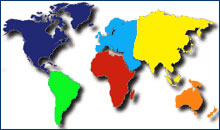A guidebook writer's guide to travel guides (cont'd)
« More about guidebooks: INtro and Rules of ThumbThe Major Series
Each of the many travel guidebook series out there caters to a specific audience: middle-class adults and families (Frommer's, Cadogan, Rick Steves, Moon Handbooks, Footprint), students and backpackers (Let's Go, Lonely Planet shoestring series), adult budget travelers (Pauline Frommer's guides, Rough Guides, Time Out, Lonely Planet Handbooks), and upscale travelers (Fodor's, Eyewitness).
Some focus on the sightseeing, art, and history (Michelin Green Guides, Blue Guides, Companion Guides, Insight). Others focus on hotels and/or restaurants (Michelin famous Red Guides, Karen Brown's B&B and Inns guides—though, since KB now charges the hotels she lists for placement on her Web site, the series can no longer be considered true travel guides but rather an advertising venue for a carefully selected clutch of hotels).
Some series go for glossy presentation and lots of pictures and diagrams—but often at the expense of information (Eyewitness, Knopf, National Geographic).
Others focus on a style or means of travel: driving tours (Frommer's, Passport); walking tours (the "Memorable Walks" series from Frommer's, [ City ] Walks from Henry Holt); or shopping (Frommer's Born to Shop).
Leaf through many; buy the ones you like.
You can find most travel guides at Barnes & Nobles (www.bn.com). If you have a hard time finding a specialty guide, try TravelStores.org (www.travelstores.org), an association of independent travel book shops around the country. Most shops reside in major cities, and are run by inveterate travelers who have personally road-tested half the books on the shelves. Bonus: most also carry a wide selection of maps, travel gadgets, and accessories (like moneybelts and electrical adapters).
Pointers & pet peeves
People always ask me what guides I travel with. That's irrelevant (though to be fair, I will tell you in a moment). You should always pick the guide that best suits your own tastes, travel needs, and interests .
I'm a fan a family-run restaurants, modest little hotels with funky charm, history and art and cultural context, and getting to know the locals wherever I go. (I also ain't rich, so that dovetails nicely with my personal travel philosophy.) These tastes inform my choice of guidebooks.
Though as a journalist I've covered more than my share of upscale restaurants and five-star hotels, they really aren't my cup of tea (nor are they in my price range), so for personal trips I don't ever bother with, say, a Fodor's or an Access guide.
At the same time, I'm not a fan of hostels, nor of hanging out with students bent solely on partying their way through Europe, so I've no use for Let's Go and its ilk. There's nothing wrong with the student-oriented guides in of themselves—or the students for that matter; I'm just talking about the type who'd rather stay back at the hostel's pub getting drunk and hooking up with fellow travelers than head out to explore some residential neighborhood. I'm just saying the books aren't for me.
For first-timer travelers
For first-time travelers-or for those traveling for the first time to a new destination—I recommend a one-two punch of Rick Steves and Rough Guides —the perfect combo of solid travel philosophy, good guidance on where to spend your precious vacation days, and the background and cultural context to make all those sights and museums come to life.
Personal favorites
Now I know I promised to list my faves. But I cannot stress enough the importance of buying the guide that's best for you. Remember: I travel for a living, so I have a fairly good grounding in the basics, and that also informs my own choices (as do my personal tastes, budget, etc).
That said, here are the books I tend to buy first when planning my own trips, more or less in order of preference (though, remember, I usually buy several). "H&R" stands for "hotels and restaurants."
- Footprint - British series; the best at giving all the niggly practical details, loads of cultural and historical background, a strong undercurrent of encouraging sustainable and responsible tourism, and a refreshingly different selection of H&R that has very little overlap with those mentioned in all the other guides.
- Rough Guides - Another British series, much better known than Footprint, with a keen focus on background and history. The H&R listings are pretty good, and tend toward the inexpensive-but-good end along with a few worthy splurges.
- Moon Handbooks - A bit like an American version of Rough Guides. Only problem: they don't do Europe. (Also, years can go by between updates).
- DK/Eyewitness - Glossy books loaded with photographs, street maps, and cut-away plans of cathedrals and museums. Descriptions are cursory at best; H&R listings are pretty weak (mostly mid- to upscale, and just the most famous places). I use all those pictures to help plan trips, but don't usually take these heavy books with me. (Disclaimer: I've written three of these things, and contributed to the current editions of the Rome and Italy books.)
- National Geographic - Gorgeous, glossy books with (as you'd expect) first-rate photography and truly insightful text. Lots of brilliant sidebar boxes and essays on cultural asides and history, good sightseeing info, fine self-guided walks, lame H&R (mostly the same, tired, famous high-end places everyone else lists). One drawback: the info can sometimes be shockingly out of date (I've read bits that I either knew, or soon discovered, to be years out of date—in one case, by more than a decade).
- Blue Guides - Like bringing along your own dry, boring, but infinitely knowledgeable professor of art and history. Encyclopedic, dreadfully dull, and absolutely necessary for us culture geeks. Lately, they've tried to add H&R and such, but they aren't doing it well.
For some destinations, certain kinds of trips, or when a title is particularly well-done, my personal second tier of choices include:
- Cadogan - Fantastic quality, and charmingly written. My only (tiny) quibble is that the hotels and restaurants tend toward the middle to upper end (and excellent choices at that), where I prefer middle to lower. That's it—and it's thoroughly a personal taste matter. Otherwise: superb travel guidebooks.
- Time Out - Especially good for big cities where I'll be spending more than a few days. Team-written, often by local experts in each field—the city paper's food critic will write up the restaurants, a history professor will cover the sights, etc. Best guidebooks for finding the hottest and latest in H&R, shops, and nightlife. Nice, breezily sophisticated style (think: alternative/events newspaper). Only problem: All they really do is cities. Also, they smell funny. (I have no idea why, but it'strue.)
- Frommer's - The most in-depth coverage of H&R of any general guidebook, a wearisome amount of detail (though perhaps I only say that because it was once my job to collect it!), and a target audience of middle-aged, middle class folks for whom comfort takes precedence over price or character (most H&R are mid- to upscale). Also, covers all the most important destinations, sights, and practical info. Could do with more cultural context (I'm guilty of trying to cram as much of that as I can in the Frommer's books I've written). A nice development is their new Pauline Frommer's Guides series (to which I contributed some on the Italy title—yeah, I know; this section is full of disclaimers. Also, I need to point out that Pauline is a personal friend). These new books aim to add more character to the Frommer's formula, and the end result is a cross between Rick Steves and traditional Frommer's, with a bit more emphasis on alternative accommodations.
- Lonely Planet - Probably the world's most popular guidebook series at the moment, but about to take a big fall. Originally, LP was focused on the budget market and designed for backpackers who wanted an overview of absolutely everything they needed to know to travel a particular country. It offered good coverage of all the travel basics, but little in the way of in-depth reading or understanding. Info was cursory at best, with particularly light-weight coverage of sights and culture. Sadly, in 2004/05 they made two major missteps. First, they redesigned most of the books to appeal to a more mid-scale audience (now, regular LP are middle priced for middle aged travelers with middle class incomes; LP's "Shoestring" series still serves the budget backpacker crowd). Second and more important, a business decision forced out almost all their best writers in order to hire more inexpensive updaters. Quality will doubtless soon suffer. With such popularity, they often suffer from the same crowd mentality as do Rick Steves and Let's Go.
- Companion Guides - Brilliant, old-fashioned, literary guides that are almost like getting a crash college course in art, history, and local culture from some charmingly erudite professor (like a Blue Guide, but with loads more character and not as encyclopedic). However, I often don't have the time to take their leisurely, day-long walks through each neighborhood, which is how they organize all the information. Also, the latest editions (after a long out-of-print hiatus) have, for some bizarre reason, been printed on thick, heavy paper stock in a large trim size when what you rally want out of a travel book—especially one designed to be carried around on every walk—is something as small and light as you can make it.
One final note: the author of any book can make a world of difference . For example, you'll notice Frommer's falls into my second tier of choices for my own travels, while Rough Guides and National Geographic are among my first choices. However, on a recent trip to Hong Kong, I discovered that the Frommer's Hong Kong was far superior and more up-to-date than either the Rough Guide, Nat. Geo. book, or Lonely Planet I also had with me.
(This realization also came as a relief to me, since the Frommer's book happens to be written by a friend of mine and I knew I'd have to tell her what I thought of it—but even if Beth weren't a buddy, I'd still heartily recommend her book over any of the others.)
Related Articles |
Outside Resources |
This article was last updated in October 2006. All information was accurate at the time.
Copyright © 1998–2010 by Reid Bramblett. Author: Reid Bramblett.



 ShareThis
ShareThis

